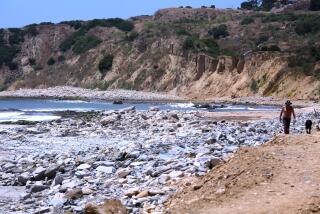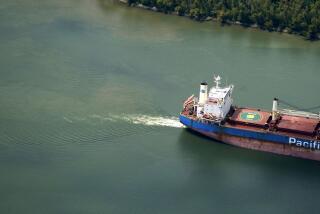The Tide May Be About to Turn for Louisiana’s Disappearing Wetlands : Environment: Natural and man-made forces have taken their toll on the marshlands. Hopes for restoration lie with a new soil diversion project.
- Share via
PASS A LOUTRE, La. — Mike Windham, wildlife biologist for the Louisiana Department of Wildlife and Fisheries, flew his Cessna 180 float plane over the Mississippi River where it spills into the Gulf of Mexico.
“See that big bay over there on the west side of the river?” Windham asked as he passed low over the Pass A Loutre Wildlife Management Area. “That bay was all marshland, 10,000 acres of prime wetlands 30 years ago.
“It’s part of the 100,000 acres or more of the Mississippi River Delta transformed from marsh to open water since 1956. We’re losing up to 50 square miles a year of Louisiana to erosion. The whole bottom of the state is disappearing.”
For 15 years, Windham, 39, has worked to prevent the wetlands from vanishing. He is a technical adviser to the Louisiana Wetlands Conservation and Restoration Plan now being developed by the governor’s office.
“This is the first time a comprehensive plan for saving the state’s wetlands is being put in place. The plan is under consideration by the Legislature with funding to come from oil and gas revenues,” he said.
The Louisiana plan calls for $20 million to be spent on wetlands’ conservation and restoration in fiscal 1990-91 and $15 to $25 million each succeeding year, contingent on oil and gas revenues. Much of the state’s coastal marshland from Texas to Mississippi is leased to gas and oil development.
Windham knows as much as anyone about the 4.5 million Louisiana wetland acres--4 million of them in private hands, 500,000 in the state’s.
He spends hours each week flying the bottom of Louisiana, visiting Wildlife and Fisheries field stations accessible only by float plane or boat.
He flies to check oil and gas development sites to ensure the marshlands aren’t harmed. He patrols the Mississippi Flyway to monitor waterfowl. He visits trappers and fishermen in swampland camps to get a feel for wildlife status.
Windham flies congressmen, scientists and coastal erosion experts over the wetlands, pointing out problem areas.
“In this job, a person has to wear many hats. The whole bottom of Louisiana is one gigantic marsh, a remote, roadless area comprising 40% of the nation’s coastal wetlands,” he said.
On this outing, Windham flew over an incredible maze of waterways and thousands of marsh islands along the final miles of the Mississippi River, where it branches into four major channels that spill into the Gulf: Main Pass, Pass A Loutre (which means otter pass in French), South Pass and Southwest Pass.
He passed over Pilot Town near the river’s end; it’s a collection of houses along a 3/4-mile boardwalk on a marsh island, which is 20 miles from the end of the nearest road and is accessible only by boat. Pilot boat crews live here in stilt houses. Each day, the crews take an average of 35 ocean-going vessels 100 miles up and down the river to and from New Orleans. As the float plane flew over Pass A Loutre Wildlife Management Area, the sky was a maze of salt-and-pepper dots--huge flocks of snow geese, cormorants, pintails, teal, white pelicans and scores of other birds hopscotched from one island to another, feeding on lush marsh grasses.
Windham explained that many factors are involved in the loss of wetlands: “Hurricanes revert hundreds of acres of marsh to open water overnight. Population explosions of nutria and muskrats eat themselves out of house and home by gobbling up all the vegetation on marsh islands, reducing the wetlands to mud flats.
“High tides rip out land. Salt water intrusion occurs.”
The biologist also cited the creation of levees for navigation along the Mississippi as a factor; the levees shunt sediment and fresh water off the Continental Shelf into the Gulf of Mexico.
“Sediments--soil, debris, silt, clay and sands--historically were deposited at places like Pass A Loutre, building up coastal wetlands. Now the sediments run out to sea,” said Windham. “A lot of the sediments that came down the river in the past are getting trapped along the Mississippi’s route from Minnesota to the Gulf.”
Part of Windham’s job at Pass A Loutre has been to oversee sediment diversion projects and construction of fences to trap debris before it is lost at the river’s mouth.
While enormous tracts of marshland have been lost, Louisiana’s Wildlife and Fisheries Department has been busy controlling coastal erosion and creating new marshland.
Windham flew over water-control structures diverting fresh water and sediments from the Mississippi into fenced-off areas where sediments are being trapped, and new islands and marshland are being created.
“Coastal erosion in the past few years has slowed. What we’re working toward is to turn the process around with adequate funding under the new state plan. Eventually, we hope to have more land added each year to the state than land lost through erosion of the coastal wetlands,” Windham said.
More to Read
Sign up for Essential California
The most important California stories and recommendations in your inbox every morning.
You may occasionally receive promotional content from the Los Angeles Times.










